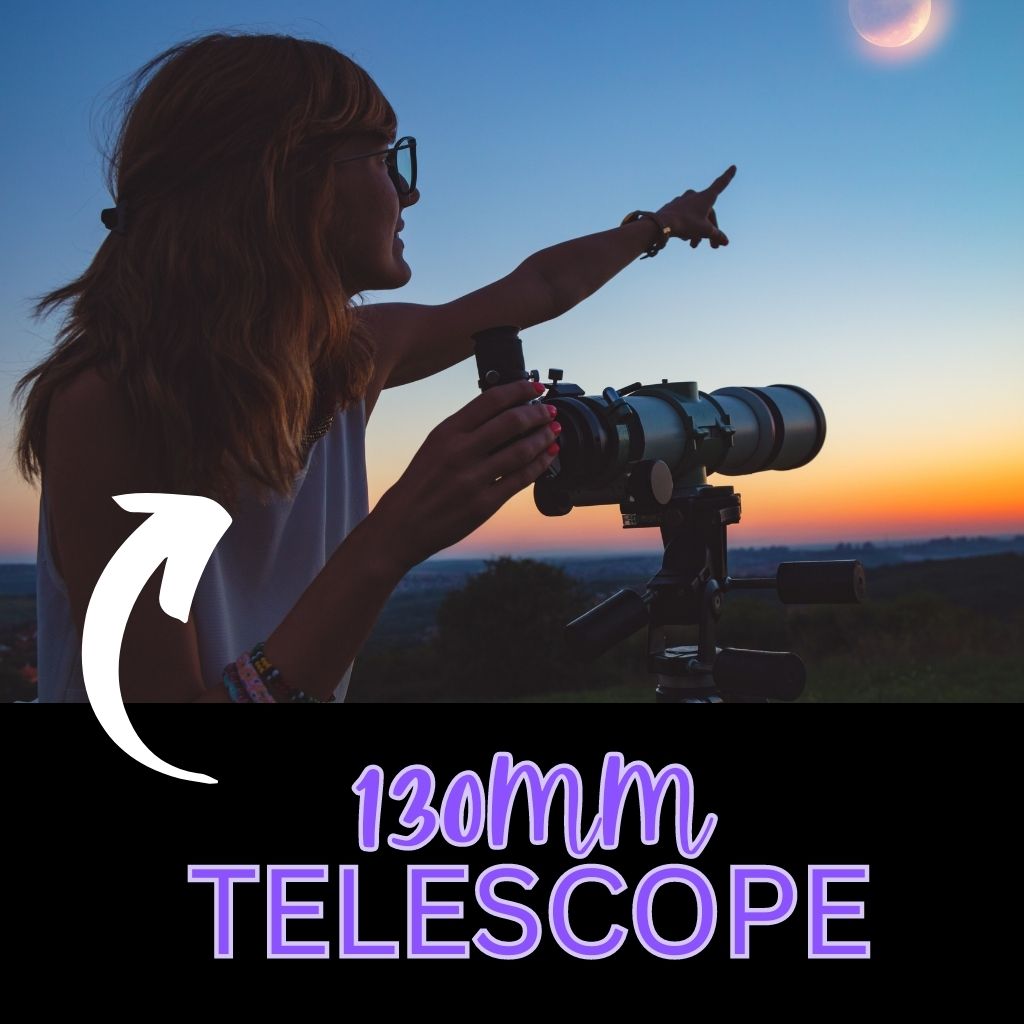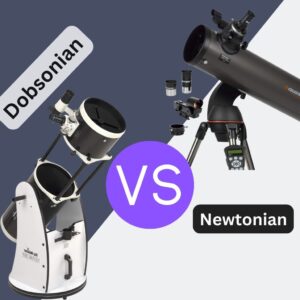This site contains affiliate links to products. I may receive a commission for purchases made through these links.
A 130mm telescope allows you to observe various celestial objects, including the Moon, planets like Saturn and Jupiter, nebulae, galaxies, star clusters, double stars, lunar features, and solar system moons.
It allows you to explore celestial objects in remarkable detail. With its modest yet capable aperture, this telescope size strikes a balance between portability and power.
If you’re an aspiring stargazer or a seasoned astronomer, the size of your telescope plays a vital role in your celestial observations. In this article, we will examine in detail what you can achieve with a 130mm telescope.
What is the magnification of a 130mm telescope?
The magnification of a 130mm telescope can vary depending on the eyepiece used. Magnification is determined by dividing the focal length of the telescope by the focal length of the eyepiece.
With a 130mm telescope, typical eyepieces range from 10mm to 25mm focal lengths.
For example, if we consider a 130mm telescope with a focal length of 650mm and use a 10mm eyepiece, the magnification would be 65x (650mm divided by 10mm).
Similarly, if we use a 25mm eyepiece, the magnification would be 26x (650mm divided by 25mm).
With its moderate focal ratio, a 130mm telescope strikes a balance between wide-field views of expansive deep space objects and detailed observations of individual celestial targets.
What to observe with a 130mm telescope?
A 130mm telescope offers a versatile range of celestial objects you can observe and explore. With its moderate aperture size, this telescope can provide clear and detailed views of various astronomical objects.
Here are some of the celestial objects you can observe with a 130mm telescope:
Moon
The 130mm telescope provides excellent views of the Moon’s craters, mountains, and lunar landscapes. You can explore the details of its surface, including the famous Sea of Tranquility and Tycho Crater.
Planets
With a 130mm telescope, you can observe the prominent features of planets such as Jupiter and its four largest moons, the phases of Venus, and the polar ice caps of Mars during favorable oppositions.
Deep sky objects
The telescope’s aperture enables you to explore numerous deep-sky objects. You can observe beautiful star clusters like the Pleiades and Beehive Cluster and nebulae such as the Orion Nebula and Lagoon Nebula.
Double stars
A 130mm telescope enables you to enjoy the beauty of double stars, where two stars orbit each other. Albireo in the constellation Cygnus is a popular example, displaying contrasting colors of gold and blue.
Star clusters
A 130mm telescope is well-suited for observing star clusters. It can gather enough light to reveal the intricate details and individual stars within these clusters.
Open clusters, in particular, are excellent targets for a 130mm telescope. Their relatively larger size and scattered arrangement make them more accessible for observation.
Globular clusters can also be observed with a 130mm telescope, although their dense nature might appear more compact compared to the larger aperture telescopes.
Nevertheless, you can still appreciate their spherical shape and the concentration of stars within.
Can I observe Saturn with a 130mm telescope?
You can definitely observe Saturn with a 130mm telescope. A telescope of this size will provide you with remarkable views of the planet and its iconic rings.
With moderate magnification, you can witness the distinct ring system of Saturn, which consists of multiple bands of ice and rock particles. You may even be able to observe the Cassini Division, a gap in the rings that adds to the planet’s mesmerizing beauty.
Depending on the atmospheric conditions and the clarity of your telescope, you may also catch glimpses of Saturn’s largest moon, Titan, which appears as a small dot near the planet.
To enhance your viewing experience, consider using filters to bring out the planet’s subtle details and observing during nights with steady atmospheric conditions.
You may also like: What Telescope Size Do I Need to See Saturn?
Can I view Andromeda with a 130mm telescope?
You can definitely view the Andromeda Galaxy (M31) with a 130mm telescope. The Andromeda Galaxy is the closest spiral galaxy to our Milky Way and is visible to the naked eye under dark sky conditions.
With a 130mm telescope, you will have a great opportunity to observe this stunning celestial object in more detail. When observing Andromeda, the telescope will reveal the galaxy as a hazy patch of light with a bright central core.
As you increase the magnification, you may start to distinguish the galaxy’s spiral structure, its central bulge, and the dust lanes that traverse its arms.
It’s a truly awe-inspiring sight and offers a glimpse into the vastness of our universe.
To enhance your viewing experience, consider using wide-field eyepieces that provide a larger field of view, allowing you to appreciate the galaxy’s size and neighboring objects.
Observing from a dark location away from light pollution will significantly improve the visibility of Andromeda and its intricate details.
Take your time to observe and explore different areas of the galaxy, as it spans a large portion of the night sky. You might even spot some of its satellite galaxies, such as M32 and M110, which are smaller companions to Andromeda.
You may also like: How Good of a Telescope Do I Need to See Andromeda?
Best 130mm telescopes
When it comes to the best 130mm telescopes, there are several excellent options available. These telescopes offer different features and capabilities, so it’s important to consider your specific needs and preferences when choosing the best one for you.
Whether you’re interested in deep-sky observing, planetary viewing, or astrophotography, these 130mm telescopes provide a solid foundation for exploring the night sky.
Here are some good telescopes in this category:
Sky-Watcher Heritage 130mm Tabletop Dobsonian Telescope – Best for observing a wide range of objects in the solar system
The Sky-Watcher Heritage 130mm Tabletop Dobsonian Telescope is a compact and powerful instrument designed for portability and ease of use.
With its 5-inch aperture, this telescope offers excellent light-gathering capabilities, allowing for clear and detailed views of celestial objects.
The tabletop design makes it convenient to set up and use in any location, making it perfect for on-the-go observations.
Its Dobsonian mount provides smooth and precise movements, making it effortless to navigate the night sky.
Celestron AstroMaster 130EQ Newtonian Telescope – Best for beginners and intermediate observers
The Celestron AstroMaster 130EQ Newtonian Telescope is popular for beginners and intermediate astronomers. Its 130mm aperture and Newtonian reflector design offer excellent light-gathering capabilities and produce clear, detailed images of celestial objects.
The telescope features a sturdy equatorial mount, providing stability and ease of tracking celestial targets. Its included accessories, such as the eyepieces and tripod, enhance the overall observing experience.
Explore FirstLight 130mm Newtonian Telescope – Best for detailed observations of planets and lunar features
The Explore FirstLight 130mm Newtonian Telescope with EQ3 is another impressive option for stargazers. This telescope combines a 130mm aperture with a solid EQ3 equatorial mount, ensuring precise tracking and smooth movements.
It comes with high-quality optics that deliver sharp views of celestial objects, including the Moon, planets, and deep-sky targets.
The included accessories, such as the eyepieces and red-dot finder, enhance the ease of use and make it an excellent choice for beginners.
StarSense Explorer DX 130AZ Smartphone App-Enabled Telescope – Best for astrophotography
The StarSense Explorer DX 130AZ is a smartphone app-enabled telescope that offers convenience and advanced technology. Its 130mm aperture and altazimuth mount provides a wide field of view and effortless navigation of the night sky.
The telescope’s 130mm aperture provides excellent light-gathering capabilities, which is beneficial for astrophotography. With the right camera attachment and techniques, you can capture impressive images of the night sky, including planets, stars, and deep-sky objects.
It is compatible with the StarSense Explorer app, which uses your smartphone’s GPS and sensors to automatically align the telescope and guide you to interesting celestial objects. It is a great option for beginners who want to explore the night sky with the help of modern technology.
Celestron NexStar 130SLT Computerized Telescope – Best for beginners and advanced stargazers
The Celestron NexStar 130SLT is a computerized telescope that combines advanced features with ease of use. Its 130mm aperture and high-quality optics deliver impressive views of celestial objects.
The telescope features a motorized mount with a database of over 40,000 objects, allowing you to easily locate and track targets with the push of a button.
The SkyAlign technology makes the initial alignment process quick and straightforward. The NexStar 130SLT is an ideal choice for both beginners and experienced astronomers looking for a telescope with computerized functionality.
Orion StarSeeker IV 130mm GoTo Reflector Telescope – Best for observing planets, the moon, and other celestial objects
Orion StarSeeker IV 130mm GoTo Reflector Telescope features a 130mm parabolic reflector and a computerized GoTo system, allowing for automatic object tracking and easy navigation of the night sky.
It is well-suited for beginners who want to explore various celestial objects without the complexity of manual pointing and tracking.
114mm vs 130mm telescope
The main difference between a 114m and 130mm telescope lies in their aperture size.
Here are other differences:
The 130mm telescope offers higher magnification compared to the 114mm telescope
With a larger aperture, the 130mm telescope allows for more detailed views of celestial objects, especially when observing planets, lunar features, and some deep-sky objects.
The higher magnification enables you to see finer details and brings you closer to the objects of interest.
The 130mm telescope has a better light gathering power than a 114mm telescope
The 130mm telescope has a larger aperture, which means it can gather more light than the 114mm telescope.
This increased light-gathering capability is advantageous when observing faint or dim objects, such as distant galaxies, nebulae, or star clusters.
The larger aperture of the 130mm telescope allows for brighter and more detailed views of these celestial objects.
The 114mm telescope is often more portable than a 130mm telescope
The 114mm telescope is often more compact and lightweight compared to the 130mm telescope. This makes the 114mm telescope easier to transport and set up.
Therefore, a 114mm telescope is suitable for those who prioritize convenience and mobility.
A 114mm telescope is typically more affordable than a 130mm telescope
Generally, the 114mm telescope tends to be more affordable compared to the 130mm telescope.
If you have budget constraints or are just starting out in astronomy, the 114mm telescope can balance performance and cost-effectiveness.
Read also: What Can I See with a 114mm Telescope?
Is a 130mm telescope worth it?
A 130mm telescope is definitely worth it for anyone interested in exploring the wonders of the night sky due to the following reasons:
Moderate aperture size
A 130mm telescope offers a larger aperture compared to smaller telescopes, allowing for better light-gathering capabilities. This means you can observe fainter objects and details with greater clarity.
Versatility
A 130mm telescope can provide a good balance between portability and performance. It is often considered a versatile option that can be used for various types of celestial observations, including planetary, lunar, and deep-sky objects.
Improved resolving power
The larger aperture of a 130mm telescope results in improved resolving power, allowing you to see finer details on celestial objects.
This is especially beneficial when observing planets, where you can distinguish features such as cloud bands, lunar craters, and the Cassini division in Saturn’s rings.
User friendly
Many 130mm telescopes are designed with user-friendliness in mind, making them suitable for beginners and experienced observers. They often come with intuitive controls, stable mounts, and compatible accessories that enhance the observing experience.
Cost effective
Compared to larger aperture telescopes, 130mm models are generally more affordable. This makes them an attractive choice for individuals who want to delve into astronomy without breaking the bank.
FAQs about 130mm telescope
Here are answers to some frequently asked questions:
What can I view with a 130mm Newtonian?
With a 130mm Newtonian telescope, you can observe a variety of celestial objects in the night sky.
Some of the notable targets include:
- Planets
- The moon
- Deep sky objects
The optical quality of a 130mm telescope ensures optimal light transmission, allowing for high-resolution views of various astronomical objects within its reach.
What can I see with a 125mm telescope?
A 125mm telescope is slightly smaller than a 130mm telescope but still capable of providing enjoyable views of various celestial objects such as the moon, planets, and brighter deep sky objects.
How does Jupiter appear when observed through a 130mm telescope?
When observing Jupiter through a 130mm telescope, you can see the planet’s distinct cloud bands, the Great Red Spot (a massive storm), and up to four of its largest moons (Io, Europa, Ganymede, and Callisto).
The telescope will reveal some of the intricate details and color variations on the planet’s surface, providing a fascinating view of this giant gas planet.
How does Saturn appear when observed through a 130mm telescope?
Saturn is a beautiful sight through a 130mm telescope. You can observe its iconic rings, which appear as a beautiful, well-defined structures surrounding the planet.
You may be able to see some of Saturn’s larger moons, such as Titan. The view of Saturn’s rings and its distinctive yellowish coloration is a highlight for many stargazers.
How does Jupiter appear when observed through a 130mm telescope?
Observing Mars through a 130mm telescope can reveal surface features such as the polar ice caps, dark areas known as “maria,” and lighter regions like the “deserts” and “highlands” on the planet.
Although Mars’ appearance varies depending on its position in its orbit, a 130mm telescope can provide decent views of these features during favorable oppositions.
Takeaway: A 130mm telescope with quality optics will provide fine details of several celestial objects
A 130mm telescope offers a fantastic opportunity to explore the night sky. With its aperture size and optical capabilities, you can observe a range of celestial objects, including the Moon, planets like Jupiter and Saturn.
Deep space objects, such as galaxies, can be observed with a 130mm telescope, revealing their mesmerizing structures and intricate details.
Planetary nebulae, with their ethereal and colorful formations, can also be explored and appreciated through the lens of a 130mm telescope.
The optical tube of a 130mm telescope plays a crucial role in delivering crisp and clear views of celestial wonders, enhancing the viewing experience.
Remember to choose a telescope that suits your observing needs, consider additional accessories like eyepieces and filters.
To fully appreciate the breathtaking sights that a 130mm telescope can reveal, finding a location with dark skies free from light pollution is essential, as it enhances the visibility and clarity of distant celestial objects.
You may also like:
- What Can You See with a 60mm Telescope?
- What Can You See With an 80mm Refractor?
- What Can You See with a 90mm Telescope?
- What Can You See With a 100mm Refractor Telescope?
- What Can You See with a 120mm Refractor?
- What Can I See With a 150mm Telescope?
- Maksutov Newtonian Telescopes (In-depth Guide)
- Celestron NexStar 130 SLT Telescope Review
- How Big of a Telescope Do You Need to See Saturn’s Rings?










